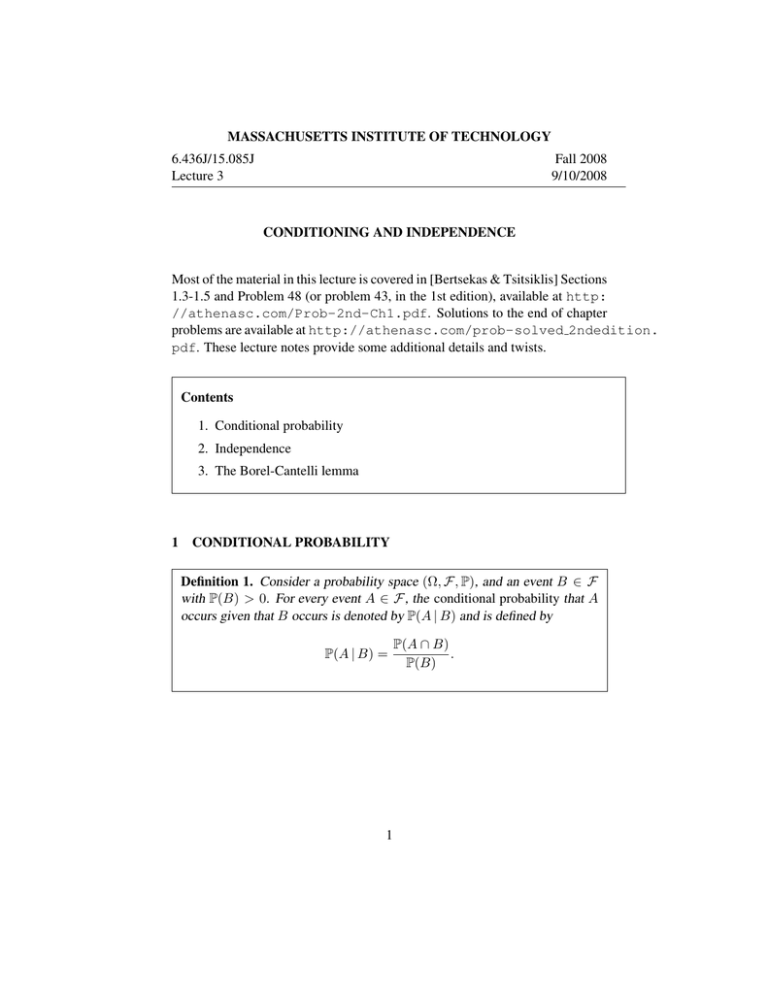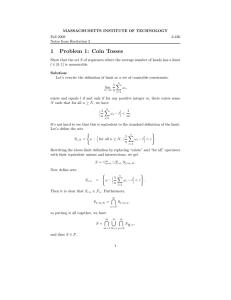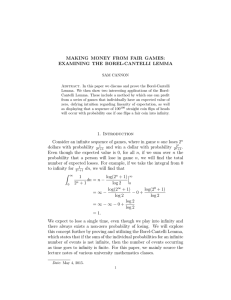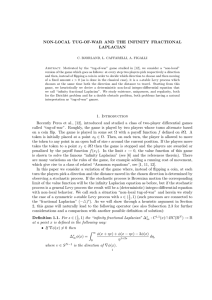MASSACHUSETTS INSTITUTE OF TECHNOLOGY 6.436J/15.085J Fall 2008 Lecture 3
advertisement

MASSACHUSETTS INSTITUTE OF TECHNOLOGY
6.436J/15.085J
Lecture 3
Fall 2008
9/10/2008
CONDITIONING AND INDEPENDENCE
Most of the material in this lecture is covered in [Bertsekas & Tsitsiklis] Sections
1.3-1.5 and Problem 48 (or problem 43, in the 1st edition), available at http:
//athenasc.com/Prob-2nd-Ch1.pdf. Solutions to the end of chapter
problems are available at http://athenasc.com/prob-solved 2ndedition.
pdf. These lecture notes provide some additional details and twists.
Contents
1. Conditional probability
2. Independence
3. The Borel-Cantelli lemma
1
CONDITIONAL PROBABILITY
Definition 1. Consider a probability space (Ω, F, P), and an event B ∈ F
with P(B) > 0. For every event A ∈ F, the conditional probability that A
occurs given that B occurs is denoted by P(A | B) and is defined by
P(A | B) =
1
P(A ∩ B)
.
P(B)
Theorem 1. Let (Ω, F, P) be a probability space.
(a) If B is an event with P(B) > 0, then P(Ω | B) = 1, and for any sequence
{Ai } of disjoint events, we have
P
�
∪∞
i=1
�
Ai | B =
∞
�
P(Ai | B).
i=1
(b) Suppose that B is an event with P(B) > 0. For every A ∈ F, define
PB (A) = P(A | B). Then, PB is a probability measure on (Ω, F).
(c) Let A be an event. If the events Bi , i ∈ N, form a partition of Ω, and
P(Bi ) > 0 for every i, then
P(A) =
n
�
P(A | Bi )P(Bi ).
i=1
In particular, if B is an event with P(B) > 0 and P(B c ) > 0, then
P(A) = P(A | B)P(B) + P(A | B c )P(B c ).
(d) (Bayes’ rule) Let A be an event with P(A) > 0. If the events Bi , i ∈ N,
form a partition of Ω, and P(Bi ) > 0 for every i, then
P(Bi | A) =
P(Bi )P(A | Bi )
P(Bi )P(A | Bi )
= �∞
.
P(A)
j =1 P(Bj )P(A | Bj )
(e) For any sequence {Ai } of events, we have
P(∩∞
i=1 Ai ) = P(A1 )
∞
�
P(Ai |A1 ∩ · · · ∩ Ai−1 ),
i=2
as long as all conditional probabilities are well defined.
Proof.
(a) We have P(Ω | B) = P(Ω ∩ B)/P(B) = P(B)/P(B) = 1. Also
�
�
� ∞
� P B ∩ (∪∞
P(∪∞
i=1 Ai )
i=1 (B ∩ Ai ))
P ∪i=1 Ai | B =
=
.
P(B)
P(B)
2
Since the sets B ∩ Ai , i ∈ N are disjoint, countable additivity, applied to the
right-hand side, yields
P
�
∪∞
i=1
�
�∞
Ai | B =
i=1 P(B
P(B)
∩ Ai )
=
∞
�
P(Ai | B),
i=1
as claimed.
(b) This is immediate from part (a).
(c) We have
�
�
�
�
P(A) = P(A ∩ Ω) = P A ∩ (∪∞
B
)
= P ∪∞
i=1 i
i=1 (A ∩ Bi )
=
∞
�
P(A ∩ Bi ) =
i=1
∞
�
P(A | Bi )P(Bi ).
i=1
In the second equality, we used the fact that the sets Bi form a partition of
Ω. In the next to last equality, we used the fact that the sets Bi are disjoint
and countable additivity.
(d) This follows from the fact
P(Bi | A) = P(Bi ∩ A)/P(A) = P(A | Bi )P(Bi )/P(A),
and the result from part (c).
(e) Note that the sequence of events ∩ni=1 Ai is decreasing and converges
� ∞to
∩∞
A
.
By
the
continuity
property
of
probability
measures,
we
have
P
∩i=1
i=1
� i
� n
�
Ai = limn→∞ P ∩i=1 Ai . Note that
�
�
P(A1 ∩ A2 ) P(A1 ∩ A2 ∩ A3 )
P(A1 ∩ · · · ∩ An )
·
···
P ∩ni=1 Ai = P(A1 ) ·
P(A1 ∩ A2 )
P(A1 ∩ · · · ∩ An−1 )
P(A1 )
n
�
= P(A1 )
P(Ai | A1 ∩ · · · ∩ Ai−1 ).
i=2
Taking the limit, as n → ∞, we obtain the claimed result.
2
INDEPENDENCE
Intuitively we call two events A, B independent if the occurrence or nonoccur­
rence of one does not affect the probability assigned to the other. The following
definition formalizes and generalizes the notion of independence.
3
Definition 2. Let (Ω, F.P) be a probability space.
(a) Two events, A and B, are said to be independent if P(A∩B) = P(A)P(B).
If P(B) > 0, an equivalent condition is P(A) = P(A | B).
(b) Let S be an index set (possibly infinite, or even uncountable), and let {As |
s ∈ S} be a family (set) of events. The events in this family are said to be
independent if for every finite subset S0 of S, we have
�
�
�
P ∩s∈S0 As =
P(As ).
s∈S0
(c) Let F1 ⊂ F and F2 ⊂ F be two σ-fields. We say that F1 and F2 are
independent if any two events A1 ∈ F1 and A2 ∈ F2 are independent.
(d) More generally, let S be an index set, and for every s ∈ S, let Fs be a σ­
field contained in F. We say that the σ-fields Fs are independent if the
following holds. If we pick one event As from each Fs , the events in the
resulting family {As | s ∈ S} are independent.
Example. Consider an infinite sequence of fair coin tosses, under the model constructed
in the Lecture 2 notes. The following statements are intuitively obvious (although a
formal proof would require a few steps).
(a) Let Ai be the event that the ith toss resulted in a “1”. If i =
� j, the events Ai and Aj
are independent.
(b) The events in the (infinite) family {Ai | i ∈ N} are independent. This statement
captures the intuitive idea of “independent” coin tosses.
(c) Let F1 (respectively, F2 ) be the collection of all events whose occurrence can be
decided by looking at the results of the coin tosses at odd (respectively, even) times
n. More formally, Let Hi be the event that the ith toss resulted in a 1. Let C be
the collection of events C = {Hi | i is odd}, and finally let F1 = σ(C), so that
F1 is the smallest σ-field that contains all the events Hi , for even i. We define F2
similarly, using even times instead of odd times. Then, the two σ-fields F1 and F2
turn out to be independent. This statement captures the intuitive idea that knowing
the results of the tosses at odd times provides no information on the results of the
tosses at even times.
(d) Let Fn be the collection of all events whose occurrence can be decided by looking
at the results of tosses 2n and 2n + 1. (Note that each Fn is a σ-field comprised of
finitely many events.) Then, the families Fn , n ∈ N, are independent.
Remark: How can one establish that two σ-fields (e.g., as in the above coin­
4
tossing example) are independent? It turns out that one only needs to check
independence for smaller collections of sets; see the theorem below (the proof
is omitted and can be found in p. 39 of [W]).
Theorem: If G1 and G2 are two collections of measurable sets, that are closed
under intersection (that is, if A, B ∈ Gi , then A ∩ B ∈ Gi ), if Fi = σ(Gi ),
i = 1, 2, and if P(A ∩ B) = P(A)P(B) for every A ∈ G1 , B ∈ G2 , then F1 and
F2 are independent.
3
THE BOREL-CANTELLI LEMMA
The Borel-Cantelli lemma is a tool that is often used to establish that a certain
event has probability zero or one. Given a sequence of events An , n ∈ N, recall
that {An i.o.} (read as “An occurs infinitely often”) is the event consisting of all
ω ∈ Ω that belong to infinitely many An , and that
{An i.o.} = lim sup An =
n→∞
∞ ∞
�
Ai .
n=1 i=n
Theorem 2. (Borel-Cantelli lemma) Let {An } be a sequence of events and
let A = {An i.o.}.
�
(a) If ∞
n=1 P(An ) < ∞, then P(A) = 0.
�∞
(b) If
n=1 P(An ) = ∞ and the events An , n ∈ N, are independent, then
P(A) = 1.
Remark: The result in part (b) is not true without the independence assumption.
Indeed, consider an arbitrary event C such that 0 < P(C)
� < 1 and let An = C
for all n. Then P({An i.o.}) = P(C) < 1, even though n P(An ) = ∞.
The following lemma is useful here and in may other contexts.
Lemma
�1. Suppose that 0 ≤ pi ≤ 1 for every i ∈ N, and that
Then, ∞
i=1 (1 − pi ) = 0.
�∞
i=1 pi
= ∞.
Proof. Note that log(1 − x) is a concave function of its argument, and its deriva­
tive at x = 0 is −1. It follows that log(1 − x) ≤ −x, for x ∈ [0, 1]. We then
5
have
log
∞
n
�
�
�
�
(1 − pi ) = log lim
(1 − pi )
n→∞
i=1
i=1
k
�
≤ log (1 − pi )
i=1
=
≤
k
�
log(1 − pi )
i=1
k
�
(−pi ).
i=1
This is true for every
� k. By taking the limit as k → ∞, we obtain log
pi ) = −∞, and ∞
i=1 (1 − pi ) = 0.
�∞
i=1 (1 −
Proof of Theorem 2.
�
�∞
(a) The assumption ∞
n=1 P(An ) < ∞ implies that limn→∞
i=n P(Ai ) = 0.
Note that for every n, we have A ⊂ ∪∞
A
.
Then,
the
union
bound implies
i=n i
that
∞
�
� �
P(A) ≤ P ∪∞
A
≤
P(An ).
i=n i
i=n
We take the limit of both sides as n → ∞. Since the right-hand side con­
verges to zero, P(A) must be equal to zero.
∞
c
(b) Let Bn = ∪∞
i=n Ai , and note that A = ∩n=1 Bn . We claim that P(Bn ) = 0.
This will imply the desired result because
∞
�
� �
c
P(Ac ) = P ∪∞
B
≤
P(Bnc ) = 0.
n=1 n
n=1
Let us fix some n and some m ≥ n. We have, using independence,
c
P(∩m
i=n Ai ) =
m
�
P(Aic ) =
i=n
m
�
�
�
1 − P(Ai ) .
i=n
�∞
�
The assumption i=1 P(Ai ) = ∞ implies that ∞
i=n P(Ai ) = ∞. Using
Lemma 1, with the sequence {P(Ai ) | i ≥ n} replacing the sequence {pi },
we obtain
m
�
�
�
c
m
c
P(Bnc ) = P(∩∞
A
)
=
lim
P(∩
A
)
=
lim
1 − P(Ai ) = 0,
i=n i
i=n i
m→∞
m→∞
6
i=n
where the second equality made use of the continuity property of probability
measures.
7
MIT OpenCourseWare
http://ocw.mit.edu
6.436J / 15.085J Fundamentals of Probability
Fall 2008
For information about citing these materials or our Terms of Use, visit: http://ocw.mit.edu/terms.







